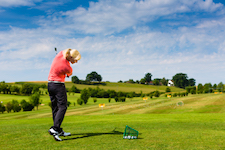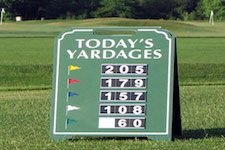HOLE 7:
PRACTICE MAKES PERFECT
Practice makes perfect? Perhaps this is a goal for golf professionals, but for a learning golfer, your goal is to feel more confident and better prepared for a round. As you practice, focus on creating repeating swings and making ball contact. If you feel stuck, join a clinic or schedule a lesson to make adjustments to your swing. In this section, you'll find guidelines and goals that will reinforce the lessons you're taking.
HOW FAR DOES EACH CLUB GO
Introduction
Golf is a game of accuracy, and each club in your bag is designed to drive the ball different distances. Distance is also determined by your physical characteristics, the features of your equipment, the weather and conditions on the course.
Of course the skill of the operator of the club has something to do with distance as well! During your practice sessions, become familiar with how far each of your clubs advance the ball, so that when you're on the golf course, you'll have an idea of which club to choose. Once you find yourself getting the ball airborne more times then not, focus one or more practice sessions determining your club distances.
Determine Your Club Distances
A typical driving range is set up with multiple flagsticks set at different intervals. Most likely there will be a sign or a plaque on the ground to indicate the distance in yards to each flag.
Pick a target in the 100 yard range, and hit a few different clubs to see which one lands the ball closest to your target. Take note of the shots that make relatively good ball contact. Once you've settled on a club that does the job, this will become your 100 yard club. From here, your clubs will most likely go longer or shorter by 10 yards as you respectively decrease and increase the loft of your club. In other words, as the number on your clubs goes lower, the ball will go longer. When the number on your club goes higher (and into the wedges), the ball will go shorter distances.
You may find that you hit with some clubs better then others. Practice with the clubs that you like the best, and aim for a consistent target. After hitting the same club over and over, you'll get a feel for how far each club will go.
If you want to be more exact, chart your distance hitting one club 25 times. Drop your lowest and highest five measurements and take an average of what remains for your club distance. Make a written note of your favorite clubs, as this will be useful when you're on the golf course. Keep in mind that the balls you use on the golf course will be better quality then range balls, so you may experience a little more distance with each club. As you improve your swing or change out your equipment, you'll want to repeat this exercise and update your distances.



Average Distances for Women
The guide below will help you choose the right club. Based on your own particular skills, strength, age and equipment, you may find your clubs go longer or shorter distances than these ranges.
Compare the average distance you hit a 7 -iron to see if you identify with the shorter, middle or longer side of these estimates for irons. Do the same with your driver and a hybrid, and develop your own chart for your clubs.
As you work towards making solid ball contact, don't be discouraged if many of your shots are shorter then these ranges. With practice, your distances will be more consistent.
Driver: 150-175-200 yards
3-wood: 125-150-180 yards
4-wood: 110-145-175 yards
5-wood: 105-135-170 yards
5-hybrid: 115-140-160
6-hybrid: 110-130-150
7-hybrid: 105-120-140
4-iron: 90-120-150 yards
5-iron: 80-110-140 yards
6-iron: 70-100-130 yards
7-iron: 65-90-120 yards
8-iron: 60-80-110 yards
9-iron: 55-70-95 yards
Pitching wedge: 50-60-80 yards
Sand wedge: 40-50-60 yards







